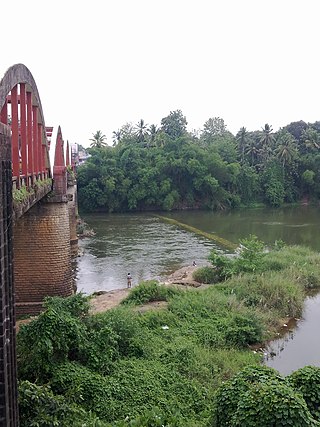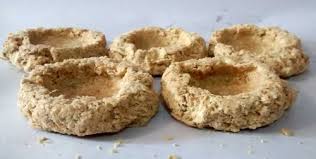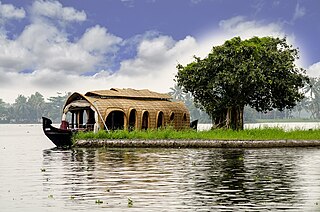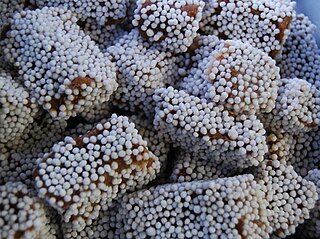
Pathanamthitta District, is one of the 14 districts in the Indian state of Kerala. The district headquarters is in the town of Pathanamthitta. There are four municipalities in Pathanamthitta: Adoor, Pandalam, Pathanamthitta and Thiruvalla.

Jaggery is a traditional non-centrifugal cane sugar consumed in the Indian subcontinent, Southeast Asia, North America, Central America, Brazil and Africa. It is a concentrated product of cane juice and often date or palm sap without separation of the molasses and crystals, and can vary from golden brown to dark brown in colour. It contains up to 50% sucrose, up to 20% invert sugars, and up to 20% moisture, with the remainder made up of other insoluble matter, such as wood ash, proteins, and bagasse fibres. Jaggery is very similar to muscovado, an important sweetener in Portuguese, British and French cuisine. The Kenyan Sukari ngutu/nguru has no fibre; it is dark and is made from sugarcane and also sometimes extracted from palm tree.

Kozhencherry is a census town in Pathanamthitta district of Central Travancore region in Kerala state, India. As of 2011 census, the population was 12,021 of which 5,594 are males while 6,427 are females.

Marayur or Marayoor is a town in Devikulam taluk of Idukki district in the southwestern Indian state of Kerala. It is located 42 kilometers north of Munnar on SH 17 connecting Munnar with Udumalpet, Tamil Nadu. Marayur is situated at around 990 metres above mean sea level and is the only place in Kerala that has natural sandalwood forests. Ancient dolmens and rock paintings in Marayur date back to the Stone Age. In 1991 Marayur had a population of 9,590.

Tilkut also known as tilkutam, gajak, tilpatti, is a sweet made in the Indian states of Bihar, Jharkhand.

Alappuzha, formerly known as Alleppey, is a city and municipality in the Alappuzha district of Kerala, India. It is the district headquarters of the district, and is located about 130 km (80.8 mi) north of the state capital Thiruvananthapuram. As per the 2011 Indian census, Alappuzha has a population of 240,991 people, and a population density of 3,675/km2 (9,520/sq mi).

Bal mithai is a brown chocolate-like fudge, made with roasted khoya and coated with white balls made of sugar coated roasted poppy seeds. It is a popular sweet from Kumaon, India.

Kadapra is a village in the Thiruvalla subdistrict of Pathanamthitta district, Kerala state, India. It shares an intradistrict river border with Nedumpuram village separated along the Manimala river towards its north and an interpenetrating intradistrict land border with Niranam village towards its west.
The Indian state of Kerala borders with the states of Tamil Nadu on the south and east, Karnataka on the north and the Arabian Sea coastline on the west. The Western Ghats, bordering the eastern boundary of the State, form an almost continuous mountain wall, except near Palakkad where there is a natural mountain pass known as the Palakkad Gap. When the independent India amalgamated small states together, Travancore and Cochin states were integrated to form Travancore-Cochin state on 1 July 1949. However, Malabar remained under the Madras province. The States Reorganisation Act of 1 November 1956 elevated Kerala to statehood.
Alibag taluka is a subdistrict/upazila/tehsil in Raigad district of the Indian state of Maharashtra.
Wayanad Jeerakasala rice is a variety of traditional, non-Basmati, medium-grained aromatic rice with golden yellow colour mainly grown in the Indian state of Kerala. It is a common and widely cultivated crop in Wayanad district. The other variety from the same region, Wayanad Gandhakasala rice is known for its sandalwood-like flavor, while Wayanad Jeerakasala rice resembles cumin seeds in both appearance and taste and are so unique from one another.

The Harmal chilli is a variety of chilli mainly grown in the Indian state of Goa.
The 'Kuttiattoor' mango or Kuttiattoor Manga, is a mango cultivar primarily grown in the village of Kuttiattoor, Kannur district of Kerala, India. 'Nambiar maanga', 'Kannapuram maanga', 'Kunjimangalam manga' and 'Vadakkumbhagam manga,' are the variations of the same name.

The Edayur chilli is a variety of chilli mainly grown in the Indian state of Kerala. The Edayur chilli is a local cultivar primarily grown in specific regions of Kerala's Malappuram district. Specifically, it is cultivated in the panchayaths of Edayur, Athavanad, Marakkara, Irimbiliyam, Kalpakanchery, and Valanchery within the Valanchery block, as well as Moorkanad and Kuruva panchayaths within the Angadippuram block.

The Kolhapur jaggery is a variety of jaggery made from fresh sugarcane juice in the Indian state of Maharashtra. It is an agri-product manufactured from sugarcane which is a common and widely cultivated crop in Kolhapur. The waters of the streams forming the Panchganga river are primarily used for sugarcane cultivation in Kolhapur. It is also the most exported variety of jaggery from India.
The Marayoor jaggery is a variety of jaggery made from fresh sugarcane juice in the Indian state of Kerala. It is an agri-product manufactured from sugarcane which is a common and widely cultivated crop in Marayoor and Kanthalloor Grama panchayaths of Devikulam taluk, Idukki district grown particularly by the farmers of Muthuva tribe.
The Muzaffarnagar jaggery is a variety of jaggery made from fresh sugarcane juice in the Indian state of Uttar Pradesh. It is an agri-product manufactured from sugarcane which is a common and widely cultivated crop majorily in the districts of Muzaffarnagar and also in Bijnor, Shamli, Baghpat, Meerut and Shajahanpur. Muzaffarnagar hosts India's largest jaggery market, accounting for 20% of the country's total jaggery production. The city's jaggery is considered lucky by many and is a significant contributor to India's traditional sweetener production.
Alibag White onion is a traditional variety of white onion grown in the Indian state of Maharashtra. It is a common and widely cultivated crop in the Alibag taluka of the Raigad district. This unique onion is characterized by its sweetness, low pungency, and high nutritional value. It is traditionally cultivated in Alibag, specifically in villages such as Karle, Khandala, Nevuli, Talvali, Sagaon, and Wadgaon. It has been recognized since 1883 in the official gazette and known for its medicinal properties, for its health benefits, including treating heart ailments, controlling cholesterol, and regulating insulin.
Kanyakumari Matti Banana is a variety of banana grown in the Indian state of Tamil Nadu. It is a common and widely cultivated crop in the Agatheeswaram, Thovalai, Thiruvattar talukas of Kanyakumari district. Kanyakumari Matti Banana ia a traditional table banana cultivar with medicinal value, characterized by its fragrant, sweet, and slightly acidic flavor, firm texture, and powdery nature and is a rare variety grown only in the hills of South Travancore which is near Nagercoil, Kanyakumari. It has three varieties: Semmatti (red-coloured), Then Matti (honey), and Malai Matti (Hill). Under its Geographical Indication tag, it is referred to as "Kanyakumari Matti Banana".